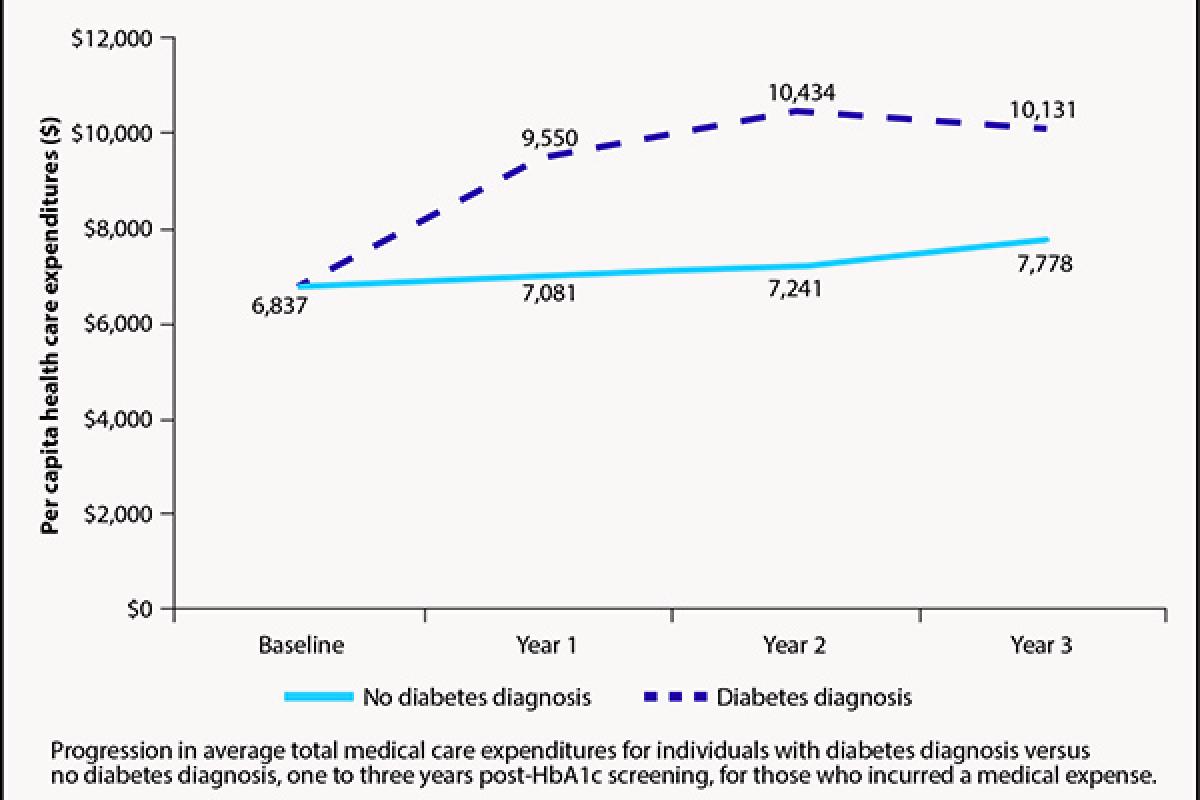An estimated 86 million adults in the U.S.—more than one in three—have prediabetes. It is expected that up to one-quarter of them will develop type 2 diabetes within five years, but the progression can be largely prevented or delayed through participation in the Centers for Disease Control and Prevention’s (CDC) National Diabetes Prevention Program (DPP). A study and an online calculator demonstrate how preventing the onset of type 2 diabetes can reduce annual health care costs by thousands of dollars per patient and generate large positive returns on investment (ROI) for health systems, insurers and employers.
For the study, published in Population Health Management, researchers looked at individual-level claims data from more than 8,000 commercially insured adults to estimate medical expenditures among individuals with prediabetes. Data on expenditures were combined with findings from previous studies to estimate net savings and ROI if they were to participate in a CDC-recognized DPP.
Researchers found that expenditures during the one-to-three-year period following HbA1c screening are one-third higher for those who develop diabetes. That amounts to an annual average of $2,671 per patient. “At that cost differential, the three-year ROI for a National DPP is estimated to be as high as 42 percent,” wrote the study’s authors, Tamkeen Khan, PhD, Stavros Tsipas and Gregory Wozniak, PhD, all of the AMA.
Patient participation in a CDC-recognized DPP in a community-based or primary care setting costs between $400 and $500 per person—far less than the ensuing average annual medical care expenditure savings. In addition, other research has shown the impact can be long-lasting: People who complete DPPs are one-third less likely to develop type 2 diabetes after 10 years.
How it works
The National DPP is a partnership of public and private organizations working to reduce the incidence of prediabetes and type 2 diabetes. It is based on evidence from a randomized clinical trial that showed patients with prediabetes who participated in a structured lifestyle change program cut their risk of developing type 2 diabetes by 58 percent over three years.
The program is one year in duration and is offered both in person and online, featuring 16 weekly sessions followed by six monthly sessions. Activities are group-based and focused on healthy diet, weight loss and increased physical activity. Goals include 5- to 7-percent weight loss through dietary change and 150 minutes of physical activity per week.
Based on results from this analysis and findings in previous studies, the authors estimated just 14 percent of patients who complete the intervention may be diagnosed with diabetes within three years, compared with 29 percent of those who do not participate.
The authors cited several limitations to the study, including varying rates of onset between patient populations, inability to stratify and control for characteristics due to sample sizes and actual attained milestones that may vary from those in the literature.
Now covered by Medicare
The need for cost-effective diabetes prevention is increasingly urgent. Between 2007 and 2012, the total economic cost of diabetes grew 41 percent, to $245 billion. It is expected to reach $336 billion by 2034.
In 2016, following a successful demonstration project, the Department of Health and Human Services announced it would cover diabetes prevention programs for Medicare beneficiaries. It was the first time a preventive service model from the Center for Medicare and Medicaid Innovation had been expanded into the Medicare program.
Despite “pockets of coverage for the National DPP, a national strategy that includes private and public programs targeting the 86 million U.S. adults with prediabetes remains missing,” the authors of the new study wrote.
“Furthermore,” they added, “increasing coverage for the National DPP through commercial insurance is one path to decreasing the afflictions associated with diabetes.”
The CDC and the AMA have been working together since 2014 to address diabetes prevention on a national level. This has included a national co-branded initiative, Prevent Diabetes STAT™, which aims to increase engagement with physicians, care teams and patients to reach some of the millions of adults with prediabetes and stop their progression to type 2 diabetes.
The AMA has also partnered with San Francisco-based Omada Health and Intermountain Healthcare, a Salt Lake City-based health system, to incorporate Omada’s online DPP into the care setting at Intermountain. The goal of the partnership is to create a road map for health care organizations across the country to integrate proven online prevention programs into physician referrals and clinical workflows.
Calculate savings for your patient population
An online tool from the AMA helps employers, insurers, health systems and others calculate net savings and ROI for their sample populations. Play with this calculator to see how upping the share of your patients who enroll in a DPP can have a sizeable effect on the number who develop diabetes and how much money can be saved through prevention.
Find a CDC-recognized program near you or online.




